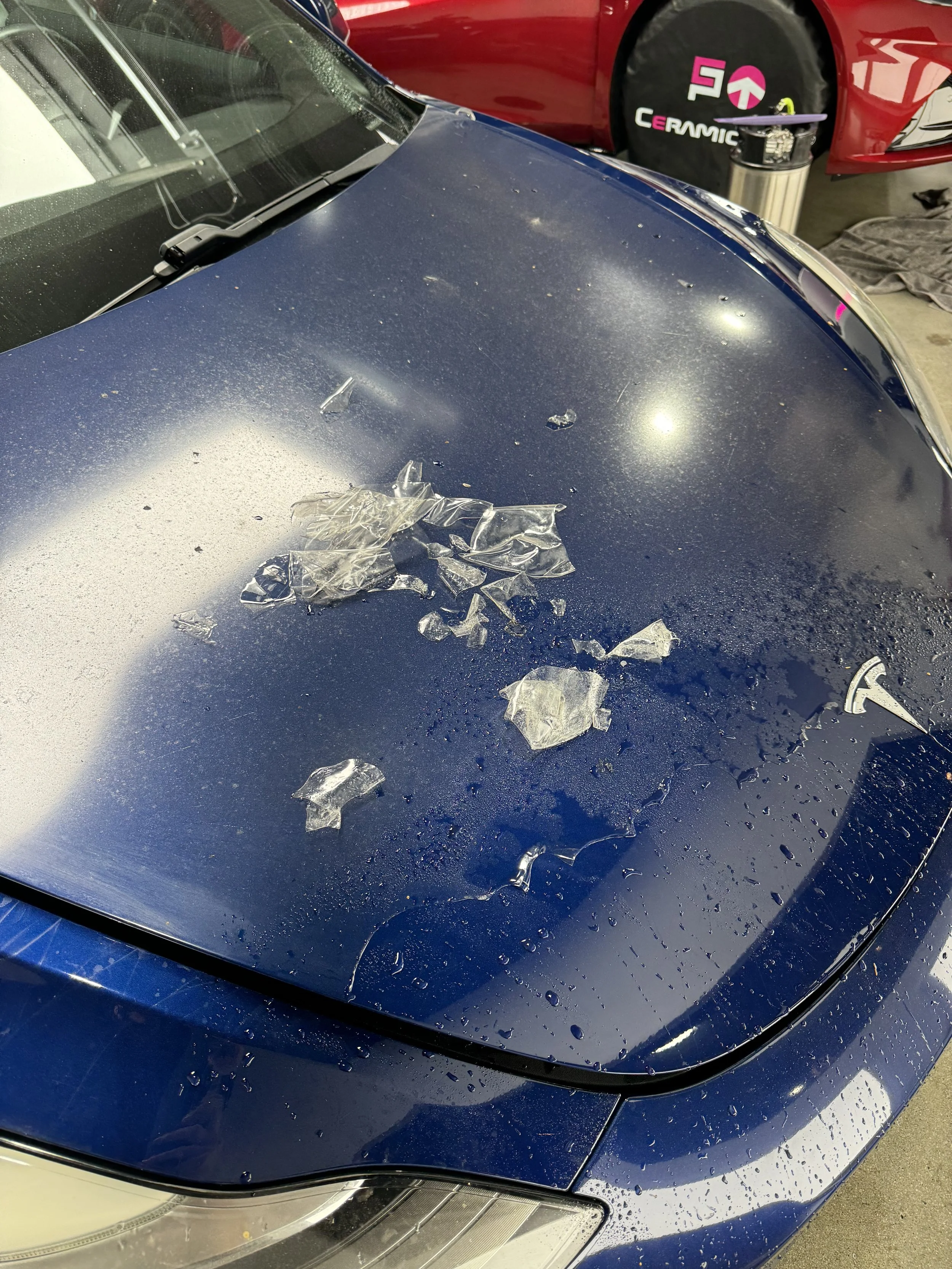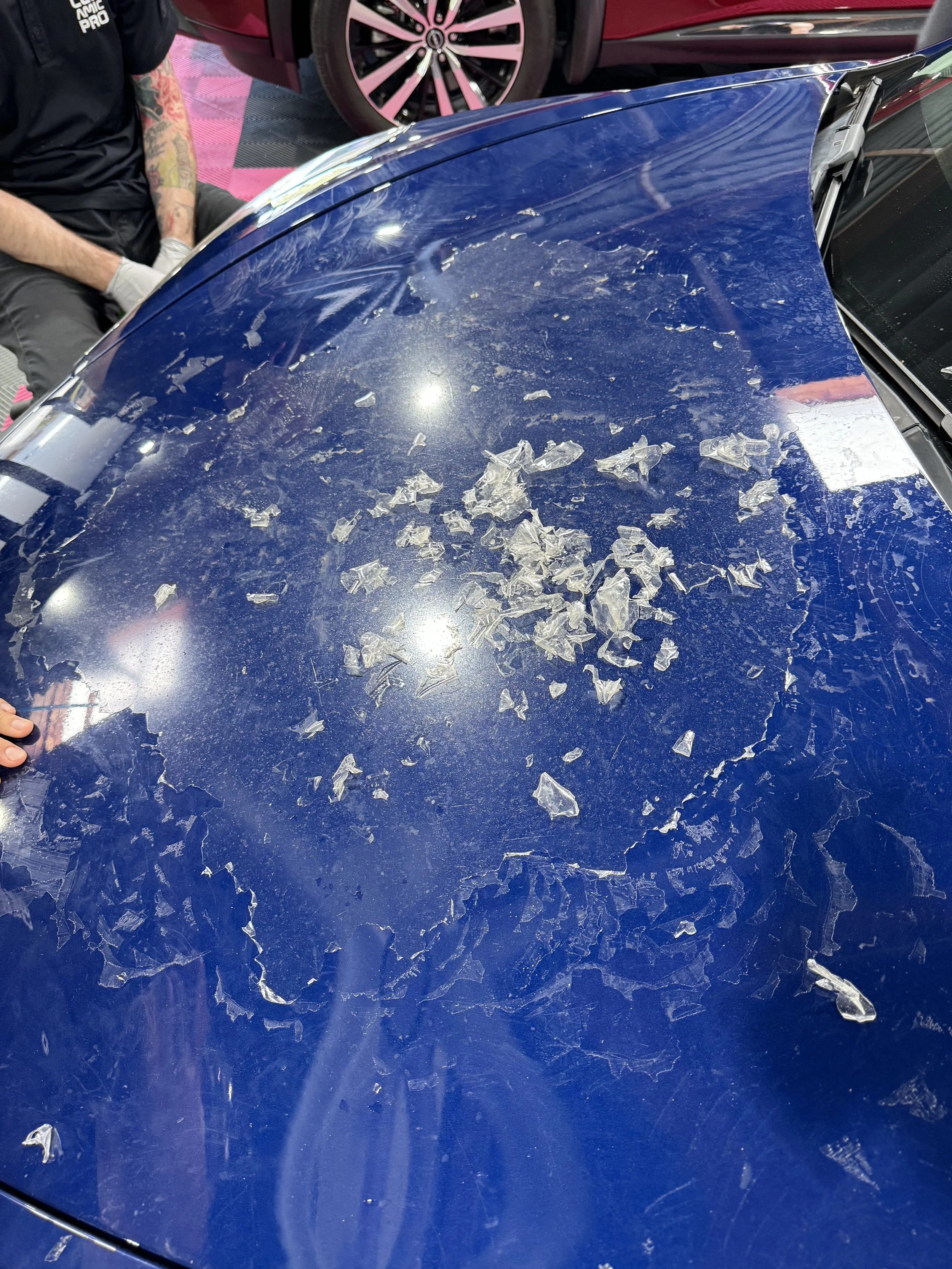When it comes to having PPF installed in the Bay Area, there are multiple factors that determine longevity however paint protection film can last as little as 3 years or as much as 10+ years when you factor in proper care for your PPF and purchasing from a quality name brand PPF manufacturer.
Overall, PPF technology has changed drastically over the last decade, so don’t let older PPF installations you saw 10-15 years ago scare you from installing it on your new vehicle today. Modern day PPF is made from high-quality TPU (Thermoplastic Polyurethane) rather than older PVC-based films, which can yellow, crack, or harden faster and results in a more difficult PPF Removal.
Let’s dive in a little more, though!
Name-Brand PPF: Why does it matter?
Purchasing a name brand PPF is probably the most important factor when it comes to getting PPF that lasts a long time and also carries a legitimate manufacturer warranty. Paint Protection Film has exploded in popularity over the last 5-10 years and dozens of brands have flooded the market. Not all PPF is made the same though and manufacturers have poured millions of dollars in R&D into their own tried and true formula’s for the adhesive, polyurethane topcoats, and more.
Given that this product is going directly on your paint and potentially going to be baked by the sun on a regular basis, you really want to make sure you have a quality film & manufacturer you can trust. One that has spent the time and resources doing R&D until they mastered a product that would not only protect a vehicle, but also be easily removable years down the road. Not only can poor quality PPF potentially ruin your paint, but it can cost you even more to remove a poor quality film than it cost to install it. A quality PPF, even after 10 years will usually remove in 1 piece if not a couple of pieces.
(Pictured below) In fact, we had a client with a Tesla Model 3 that had a no name brand of PPF installed only 3 years ago and it was already completely faded and cracking. The shop that originally installed the film had gone out of business and she was now looking for someone else to remove the faded PPF from her hood. The removal process was pain-staking to say the least. The topcoat was coming off in hundreds of pieces because it practically disintegrated and the adhesive had turned into a hard glue that was basically baked into her paint. After all was said and done, it took 12 hours to remove the PPF off the hood and polish it up again.
Here’s an Instagram reel of this exact car, process, and the finished results: Tesla Model 3 PPF Removal
Top Name Brand Manufacturers Include: 3M, SunTek, Llumar, XPEL, Ceramic Pro, STEK, and FlexiShield
This Customer only had this Counterfeit PPF on their car for 3 years and it completely failed. The film itself came off in 100’s of little pieces.
To make matters worse, the adhesive turned to a hard glue that bonded with the paint. The entire removal took 12+ hours to complete.
Different Tiers of PPF from each Manufacturer:
Nowadays all Paint Protection Film manufacturers have multiple tiers of film that they offer. This isn’t to say that their lowest quality films aren’t a great choice for your car, however their higher end films will always last longer and sometimes offer even more protection.
Lower Tier Films:
These films typically carry a 5 to 8 year warranty
Less advanced topcoat and typically no self-healing effects
Usually thinner film ranging from 6-7 mils.
Higher Tier Films:
Better longevity and warranty ranging from 10-12 years
More advanced self-healing topcoats (Sometimes infused with a Ceramic Coating as well for additional protection against bird droppings, tree sap, etc)
Tend to be thicker around 8 mils, however some brands carry an extra thick 10 mil film for track enthusiasts or those just looking for more protection.
Proper Care, Driving Frequency, & Environmental Exposure:
Care & Maintenance: Although PPF currently offers the most durable protection from automotive paint, it still needs to be maintained. Regular washing (ever 2-4 weeks) helps keep all of your PPF surfaces in the best shape. An annual maintenance detail (wash & claybar treatment) also helps to remove any stubborn contamination buildup on the PPF that regular washing can’t remove.
Garage Kept Vehicles: When cared for properly, garage kept vehicles might see their Paint Protection Film last longer than the manufacturers intended warranty period. In fact some of our clients have gone 15+ years with their PPF. The reason for this increased longevity is that sun exposure is one of the main factors for PPF degradation over time. Most people don’t realize that a hood or roof on a black vehicle can reach upwards of 150-170 degrees on a hot summer day in the Bay Area. In fact, as I’m writing this, it’s currently 93 degrees in Santa Clara, CA and I can see heatwaves coming off the hood of my car outside. This also includes surrounding cities such as Sunnyvale, San Jose, Mountain View, Cupertino, Los Gatos, Milpitas, Fremont, Saratoga, Morgan Hill, Campbell, and Los Altos.
Driving Frequency: Paint protection film is intended to protect the car from rock chips, road debris, and other environmental elements. The more you drive your car, the faster the PPF will show signs of aging or damage from road debris. Daily drivers will see the most wear and tear on their Paint Protection Film however “weekend cars” are naturally going to see much less. If it’s a track or off-road vehicle, then you’re going to see even more wear on your PPF than a daily driver due to the high speeds or off-road conditions.
Regardless, It’s important to remember that it’s always better to have your film looking worn up after 5-10 years rather than your factory paint. You can always replace PPF but you can never replace the quality of a factory paint job, especially in California. If you ever need to repaint your vehicle, body shops are required to use water-based paints due to strict EPA regulations.
Hard Water, Bird Droppings, and Tree Sap: While PPF does a fantastic job as protecting against rocks, it can still be stained by bird droppings, tree sap, or even hard water from sprinklers/etc. Bird droppings for example are acidic and when left on a surface for too long, can stain or etch the finish. Since PPF can’t be polished like paint, it’s always recommended to Ceramic Coat the top of your PPF to give it that extra chemical resistance against environmental contaminants.
There’s no question that Paint Protection Film is the most durable protection for your car today, however now you realize that there are multiple factors that can contribute to it’s longevity on your car. Just like with any product or service in the world, everything improves over time and PPF looks drastically different than it did 10-15+ years ago. You can now get full panel coverage instead of partial hoods & fenders, edges fully wrapped and tucked, and film that looks just as glossy as factory paint. With a proper installation & care, you won’t even know it’s there!
Click the link below to get a quote for PPF installation in the Bay Area including San Jose, Sunnyvale, Saratoga, Cupertino, Los Gatos, Milpitas, Mountain View, Fremont, and Morgan Hill.



